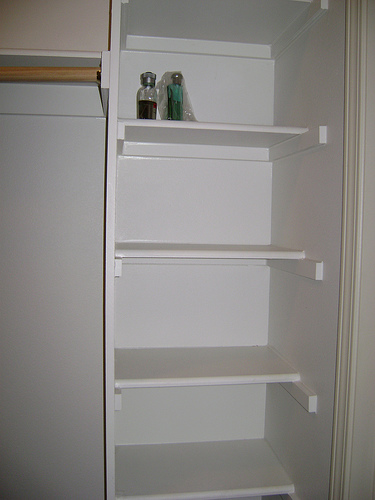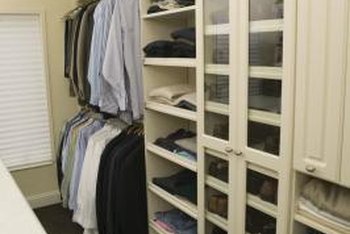If you’re looking to do a DIY project in your home, a great place to start is with your closet shelving. Not only can you save money by doing it yourself, but you can also customize it to fit your specific needs and style. Here are some different types of wood closet shelving options to consider and their benefits.
Table of Contents
Pine Wood Shelving
 Pine wood is a popular choice for closet shelving due to its affordability and availability. It is a softwood, so it is easy to work with, making it a great option for a DIY project. Pine wood has a light color and can be stained or painted to match your desired look. Some benefits of pine wood shelving include its affordability and versatility. Pine wood is also a sustainable choice, as it is grown in many areas of the world.
Pine wood is a popular choice for closet shelving due to its affordability and availability. It is a softwood, so it is easy to work with, making it a great option for a DIY project. Pine wood has a light color and can be stained or painted to match your desired look. Some benefits of pine wood shelving include its affordability and versatility. Pine wood is also a sustainable choice, as it is grown in many areas of the world.
Why Choose Pine Wood Shelving?
Pine wood shelving is a great option for those on a budget. It is also a versatile choice, as it can be painted or stained to match your desired look. Pine wood is grown all over the world, making it a sustainable choice as well.
Types of Pine Wood Shelving
There are a few different types of pine wood shelving to consider:
- Unfinished Pine Wood Shelving: This is a bare-bones option that is affordable and easy to customize.
- Pre-Finished Pine Wood Shelving: This is a more expensive option that is already finished and ready to install.
- Kiln-Dried Pine Wood Shelving: This is a higher-quality option that has been kiln-dried to remove moisture, making it more durable.
Benefits of Pine Wood Shelving
- Affordable option
- Versatile, can be painted or stained
- Sustainable choice
Advantages of Pine Wood Shelving
- Easy to work with
- Lightweight
- Natural look
How to Install Pine Wood Shelving
Installing pine wood shelving is a relatively easy process:
- Measure the space where the shelving will go
- Cut the pine wood to size using a saw
- Sand the edges and surfaces of the pine wood
- Install the bracket supports for the shelving
- Attach the pine wood to the bracket supports
Tips for Working with Pine Wood Shelving
- Use a sharp saw to avoid splintering the wood
- Sand the edges and surfaces of the wood to avoid any rough spots
- Make sure your measurements are precise to ensure a proper fit
Melamine Shelving
 Melamine shelving is a popular choice for closet shelving due to its durability and versatility. It is made from a combination of wood particles and resin, which makes it a strong and durable option. Melamine shelving is also easy to clean and can be cut to fit any space. Some benefits of melamine shelving include its durability and low maintenance.
Melamine shelving is a popular choice for closet shelving due to its durability and versatility. It is made from a combination of wood particles and resin, which makes it a strong and durable option. Melamine shelving is also easy to clean and can be cut to fit any space. Some benefits of melamine shelving include its durability and low maintenance.
Why Choose Melamine Shelving?
Melamine shelving is a durable option that requires little maintenance. It is also versatile, as it can be cut to fit any space and is available in many colors and patterns.
Types of Melamine Shelving
There are a few different types of melamine shelving to consider:
- Standard Melamine Shelving: This is the most common type of melamine shelving and is available in many colors and patterns.
- Thermally Fused Melamine Shelving: This type of melamine shelving is created by fusing a melamine sheet to a particleboard or MDF core, creating a stronger and more durable option.
Benefits of Melamine Shelving
- Durable and strong option
- Available in many colors and patterns
- Easy to maintain and clean
Advantages of Melamine Shelving
- Can be cut to fit any space
- Resistant to scratches and stains
- Eco-friendly option made from recycled wood particles
How to Install Melamine Shelving
Installing melamine shelving is a relatively easy process:
- Measure the space where the shelving will go
- Cut the melamine shelving to size using a saw
- Sand the edges and surfaces of the melamine shelving
- Install the bracket supports for the shelving
- Attach the melamine shelving to the bracket supports
Tips for Working with Melamine Shelving
- Use a fine-toothed saw blade to avoid chipping the melamine
- Use a straight edge to ensure straight cuts
- Sand the edges and surfaces of the melamine to avoid rough spots
Redwood Shelving
 Redwood shelving is a high-end option that is known for its durability and natural beauty. It is a strong and resilient wood that has a distinctive warm color and beautiful grain. Redwood is also resistant to insects, rot, and decay, making it a great option for long-term use. Some benefits of redwood shelving include its beauty, durability, and resistance to insects and rot.
Redwood shelving is a high-end option that is known for its durability and natural beauty. It is a strong and resilient wood that has a distinctive warm color and beautiful grain. Redwood is also resistant to insects, rot, and decay, making it a great option for long-term use. Some benefits of redwood shelving include its beauty, durability, and resistance to insects and rot.
Why Choose Redwood Shelving?
Redwood shelving is a high-end option that is known for its natural beauty and durability. It is resistant to insects, rot, and decay, making it a great option for long-term use.
Types of Redwood Shelving
There are a few different types of redwood shelving to consider:
- Unfinished Redwood Shelving: This is a bare-bones option that allows you to customize the finish to your liking.
- Pre-Finished Redwood Shelving: This is a more expensive option that is already finished and ready to install.
- Reclaimed Redwood Shelving: This is a sustainable option that is made from recycled redwood.
Benefits of Redwood Shelving
- Natural beauty and warmth
- Highly durable and resistant to insects, rot, and decay
- Low maintenance
Advantages of Redwood Shelving
- Long-lasting and strong
- Affordable option for a high-end look
- Sustainable choice
How to Install Redwood Shelving
Installing redwood shelving is a relatively easy process:
- Measure the space where the shelving will go
- Cut the redwood shelving to size using a saw
- Sand the edges and surfaces of the redwood shelving
- Install the bracket supports for the shelving
- Attach the redwood shelving to the bracket supports
Tips for Working with Redwood Shelving
- Use a sharp saw to avoid splintering the wood
- Sand the edges and surfaces of the wood to avoid any rough spots
- Wear protective gear, such as eyewear and a respirator, as redwood can produce a lot of dust and debris when cut
Conclusion
When it comes to choosing the right wood for your closet shelving, there are many options to consider. Pine wood is a great option for those on a budget, while melamine shelving is a durable and versatile option that requires little maintenance. Redwood shelving is a high-end option that is known for its natural beauty and durability. No matter which option you choose, be sure to measure carefully and take your time during the installation process to ensure a proper fit and finish.
 Woodworking Ideas Latest Woodworking Design Ideas
Woodworking Ideas Latest Woodworking Design Ideas


